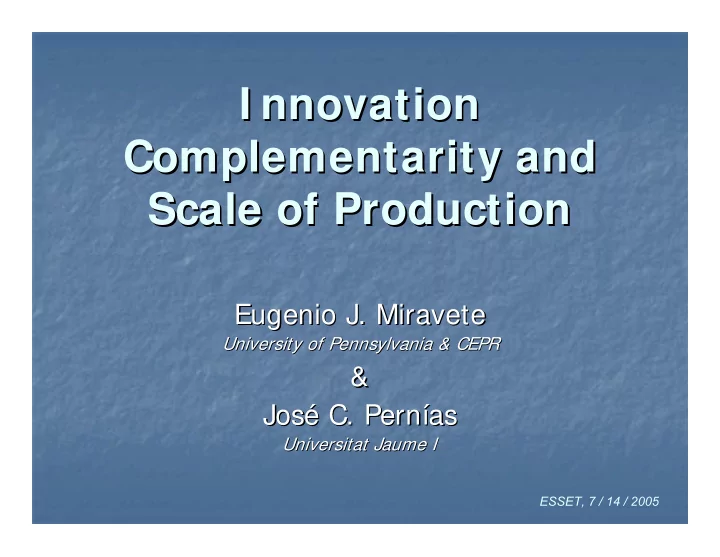

I nnovation I nnovation Complementarity and and Complementarity Scale of Production Scale of Production Eugenio J. Miravete Eugenio J. Miravete University of Pennsylvania & CEPR University of Pennsylvania & CEPR & & José é C. Pern C. Perní ías as Jos Universitat Jaume Jaume I I Universitat ESSET, 7 / 14 / 2005
Motivation � Management applications of lattice-based theoretical models have focused their attention on the following issues: � Finding out the source of the observed correlation among firms’ own strategies. � Evaluating the “externalities” that some particular incentives may have in other areas of the firm. � Designing the proper organizational structure of firms. 2
� In this paper we: � Estimate a model of production, product, and process innovation decision in the Spanish tile industry. � Develop a structural model that allows to distinguish whether the observed correlation among strategies is due to: � Complementarities. � Unobserved firms’ heterogeneity. � Ignore strategic complementarities. 3
� Building blocks: � Athey and Schmutzler (1995). � Athey and Stern (1998). � A large selection of unworthy empirical papers. � Simplistic econometric methods. � Testing cannot distinguish between: � Complementarity. � Unobserved heterogeneity. � Missing variables. � Misspecification of the econometric model. 4
� Findings: � Managerial ability is responsible for realizing the potential benefits of simultaneous adoption of innovations. � Technology eases product innovation for smaller firms. � Larger firms could also profit more from process innovation but unobserved market conditions reduces this return. 5
The Spanish Ceramic Tile Industry � Second largest in the world. � Clustered in a small area on the east of Spain. � Data covers the initial 7 years of Spain’s EU membership (1986-1992). � Suffered from technological backwardness in the early 1980s. � It was able to compete only based on low wages. � Major innovation became available in the 80s. 6
� The single-firing furnace: vs. product specific firing furnace. � vs. full/half cycle double firing furnace. � � Major innovation. � Required a major restructuring of the firm. � Energy efficient. � Automated process. � Integrated design and production of multiple varieties. � Allowed the production of new high-quality products: � Low water absorption. � Large tile dimensions. � Non-squared shapes. � Large selection of colors and design. 7
� Motivating story: � Economic growth (1985-1992) leads to wage increases. � Access to European markets allows for potentially large markups. � Increasing returns to process innovation. � Technology facilitates new designs. � Management realizes the potential profits of new products. 8
9
� Supermodularity of the profit function in production, product, and process innovation leads to complementarity relationships among these choice variables and to empirical association among strategies. 10
Model 11
� Specification: � Firm’s Environment: 12
� After transformations… 13
� Model features: � Returns to each strategy distinguish between observable and unobservable sources. � Supermodularity of the profit function only depends on parameters δ dc , δ dy , and δ cy , but not on the correlation of unobserved environmental variables. � Returns to each strategy exclude some set of environmental variables. � Unobserved heterogeneity leads to strategy association � Correlation among strategies may also be caused by observable environmental variables common to different strategy returns θ d , θ c , or θ y . 14
� Estimation based on innovation profiles. � To innovate both in product and process: 15
� Innovation profiles: 16
� Some added econometric difficulty (complements): 17
� Some added econometric difficulty (substitutes): 18
Behavioral Model � Common effects: � Time trend (reputation, experience,…). � Entry and exit. � Revenues ( Z r ): � Exports, EU indicator, Trademarks. � Production costs ( Z c ): � Age of the firm. � Adoption costs ( Z k ): � Number of products. 19
20
Results � Model specifications I-IV: � Non-existence of complementarity is always rejected. � The association among strategies cannot be attributed to a single source. � A specification that includes both, complementarity and unobserved heterogeneity dominates any other. � Restricted specifications pick up the wrong effect of the excluded source of association. 21
� Returns to each strategy: Product innovation: � � Trademarks (+, ++) � Multiproduction (++) learning spillovers � Exit (-) declining firm Process innovation: � � Age (-) old fashion firms � Multiproduction (++) scope economies Scale of production: � � Exports (+) small firms mostly sell in the domestic market � Trademarks (+, ++) small firms mostly sell unbranded products � Age (+) newly created firms designed for lower scale � Exit (-) declining firm 22
� Source of association: Product – Process. � � Unobserved heterogeneity: Managerial and organizational features of firms that are difficult to account for. Product – Scale. � � Technological: Single-firing furnace is suitable for smaller minimum efficient scale of production. Process – Scale. � � Technological: Larger firms benefit more from process innovation. � Unobserved heterogeneity: Lack of experience, poor manager background, or lack of access to markets. 23
In the Future…? � Several additional strategies. Continuous strategies. Straightforward. � Dichotomous strategies. Simulation methods vs. ML. � � Dynamic complementarities. Richer panel data required. � � Integrating the “return” and “adoption” approaches. Estimate our model simultaneously with the profit function imposing cross- � equations restrictions. Allows to identify the direct effect of observable characteristics on the � revenue, production cost, and innovation cost functions. 24
Recommend
More recommend